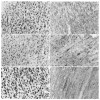Endothelin and the neurovascular unit in pediatric traumatic brain injury
- PMID: 21801587
- PMCID: PMC3545647
- DOI: 10.1179/016164111X12881719352138
Endothelin and the neurovascular unit in pediatric traumatic brain injury
Abstract
Objective: This study characterized the association between endothelin-1, cerebral hemodynamics, and histopathology after fluid percussion brain injury in the newborn pig.
Methods: Lateral fluid percussion injury was induced in newborn pigs equipped with a closed cranial window. Cerebral blood flow was determined with radiolabeled microspheres and cerebrospinal fluid endothelin-1 was measured by radioimmunoassay.
Results: Cerebrospinal fluid endothelin-1 was increased from 26±4 to 296±37 pg/ml (∼10(-10) M) at 8 hours following fluid percussion injury. Post-injury treatment (30 minutes) with the endothelin-1 antagonist BQ-123 (1 mg/kg, intravenous) blocked pial artery vasoconstriction to topical endothelin-1 (∼10(-10) M) and blunted fluid percussion injury-induced reductions in cerebral blood flow at 8 hours post-insult (56±6 and 26±4 ml/minute versus 57±6 and 40± ml/minute; 100 g for cerebral blood flow before injury and 8 hours post-fluid percussion injury in vehicle and BQ-123 post-treated animals, respectively). Fluid percussion injury resulted in neuronal cell loss and decreased microtubule associated protein 2 immunoreactivity in the parietal cortex, which were blunted by BQ-123.
Discussion: These data indicate that fluid percussion injury-induced changes in cerebral hemodynamics are associated with neuronal damage and that endothelin-1 contributes to fluid percussion injury-induced histopathologic changes.
Figures


Similar articles
-
Role of endothelin in pial artery vasoconstriction and altered responses to vasopressin after brain injury.J Neurosurg. 1996 Nov;85(5):901-7. doi: 10.3171/jns.1996.85.5.0901. J Neurosurg. 1996. PMID: 8893730
-
Dopamine prevents impairment of autoregulation after traumatic brain injury in the newborn pig through inhibition of Up-regulation of endothelin-1 and extracellular signal-regulated kinase mitogen-activated protein kinase.Pediatr Crit Care Med. 2013 Feb;14(2):e103-11. doi: 10.1097/PCC.0b013e3182712b44. Pediatr Crit Care Med. 2013. PMID: 23314184 Free PMC article.
-
Endothelin production links superoxide generation to altered opioid-induced pial artery vasodilation after brain injury in pigs.Stroke. 1997 Jan;28(1):190-6; discussion 197. doi: 10.1161/01.str.28.1.190. Stroke. 1997. PMID: 8996511
-
Cerebral hemodynamics after traumatic brain injury of immature brain.Exp Toxicol Pathol. 1999 Feb;51(2):137-42. doi: 10.1016/S0940-2993(99)80087-6. Exp Toxicol Pathol. 1999. PMID: 10192582 Review.
-
Endothelins and the role of endothelin antagonists in the management of posttraumatic vasospasm.Curr Pharm Des. 2004;10(18):2185-92. doi: 10.2174/1381612043384178. Curr Pharm Des. 2004. PMID: 15281894 Review.
Cited by
-
Oxidative Stress and the Neurovascular Unit.Life (Basel). 2021 Jul 29;11(8):767. doi: 10.3390/life11080767. Life (Basel). 2021. PMID: 34440511 Free PMC article. Review.
-
A neurovascular unit-on-a-chip: culture and differentiation of human neural stem cells in a three-dimensional microfluidic environment.Neural Regen Res. 2022 Oct;17(10):2260-2266. doi: 10.4103/1673-5374.337050. Neural Regen Res. 2022. PMID: 35259847 Free PMC article.
-
Impaired Cerebral Perfusion in Multiple Sclerosis: Relevance of Endothelial Factors.Biomark Insights. 2018 May 18;13:1177271918774800. doi: 10.1177/1177271918774800. eCollection 2018. Biomark Insights. 2018. PMID: 29795976 Free PMC article. Review.
-
Challenging the Pleiotropic Effects of Repetitive Transcranial Magnetic Stimulation in Geriatric Depression: A Multimodal Case Series Study.Biomedicines. 2023 Mar 21;11(3):958. doi: 10.3390/biomedicines11030958. Biomedicines. 2023. PMID: 36979937 Free PMC article.
-
TBI sex dependently upregulates ET-1 to impair autoregulation, which is aggravated by phenylephrine in males but is abrogated in females.J Neurotrauma. 2012 May 1;29(7):1483-90. doi: 10.1089/neu.2011.2248. Epub 2012 Mar 29. J Neurotrauma. 2012. PMID: 22335188 Free PMC article.
References
-
- Rodriguez JG. Childhood injuries in the United States. A priority issue. Am J Dis Child. 1990;144:625–6. - PubMed
-
- Wei EP, Dietrich WD, Povlishock JT, Navari RM, Kontos HA. Functional, morphological, and metabolic abnormalities of the cerebral microcirculation after concussive brain injury in cats. Circ Res. 1980;46:37–47. - PubMed
-
- Richards HK, Simac S, Piechnik S, Pickard JD. Uncoupling of cerebral blood flow and metabolism after cerebral contusion in the rat. J Cereb Blood Flow Metab. 2001;21:779–81. - PubMed
-
- Bruce DA, Alavi A, Bilaniuk L, Dolinskas C, Obrist W, Uzzell B. Diffuse cerebral swelling following head injuries in children: the syndrome of ‘malignant brain edema’. J Neurosurg. 1981;54:170–8. - PubMed
-
- Adelson PD, Clyde B, Kochanek PM, Wisniewski SR, Marion DW, Yonas H. Cerebrovascular response in infants and young children following severe traumatic brain injury: a preliminary report. Pediatr Neurosurg. 1997;26:200–7. - PubMed
Publication types
MeSH terms
Substances
Grants and funding
LinkOut - more resources
Full Text Sources
